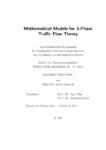| dc.description.abstract | In this thesis we outline the Kerner’s 3-phase traffic flow theory, which states that the flow of vehicular traffic occur in three phases i.e. free flow, synchronized flow and wide moving jam phases. A macroscopic 3-phase traffic model of the Aw-Rascle type is derived from the microscopic Speed Adaptation 3-phase traffic model developed by Kerner and Klenov [J. Phys. A: Math. Gen., 39(2006), pp. 1775–1809]. We derive the same macroscopic model from the kinetic traffic flow model ofKlar and Wegener [SIAM J. Appl. Math., 60(2000), pp. 1749–1766] as well as that of Illner, Klar and Materne [Comm. Math. Sci., 1(2003), pp. 1–12]. In the abovestated derivations, the 3-phase traffic theory is constituted in the macroscopic modelthrough a relaxation term. This serves as an incentive to modify the relaxation termof the ‘switching curve’ model of Greenberg, Klar and Rascle [SIAM J. Appl. Math.,63(2003), pp.818–833] to obtain another macroscopic 3-phase traffic model, which is still of the Aw-Rascle type. By specifying the relaxation term differently we obtain three kinds of models, namely the macroscopic Speed Adaptation, the Switching Curve and the modified Switching Curve models. To demonstrate the capability of the derived macroscopic traffic models to reproduce the features of 3-phase traffic theory, we simulate a multi lane road that has a bottleneck. We consider a stationary and a moving bottleneck. The results of the simulations for the three models are compared. | en_US |

